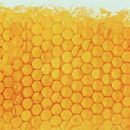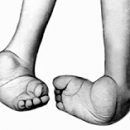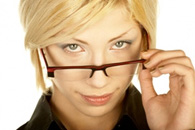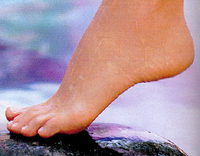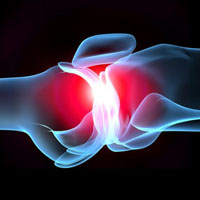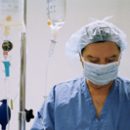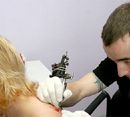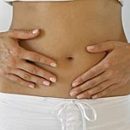Spinal curvature represents a change in the normal spinal configuration. The most common cause of the development of the spinal curvature is the wrong seat for the parties at school age.
Content
The concept of spinal curvature
Spinal curvature is a change in the normal spinal configuration. The spine of an adult is a properly folded person has characteristic bends:
- In the cervical spine rejected by convexity forward (cervical lordosis)
- In the breast - back (chest kyphosis)
- In the lumbar section - Forward (lumbar lordosis)
- in the sacral division - back
Lateral bends Normal spine does not have. The bends of the spine are formed in childhood.
Causes of spinal curvature
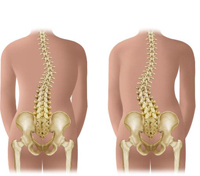 The curvature of the spine may occur with violations of the normal intrauterine development of the skeleton - the formation of wedge-shaped and additional vertebrae, improper formation of the 5th lumbar vertebra and ribs and t. NS. These are congenital spinal curvature. Sometimes the spinal curvature arise as a result of some disease (rickets, poliomyelitis, tuberculosis, pleurisy, radiculitis, etc.), injuries (spinal fractures), with disturbances of the right standing, with different length of the lower limbs, the absence of one of the limbs and.
The curvature of the spine may occur with violations of the normal intrauterine development of the skeleton - the formation of wedge-shaped and additional vertebrae, improper formation of the 5th lumbar vertebra and ribs and t. NS. These are congenital spinal curvature. Sometimes the spinal curvature arise as a result of some disease (rickets, poliomyelitis, tuberculosis, pleurisy, radiculitis, etc.), injuries (spinal fractures), with disturbances of the right standing, with different length of the lower limbs, the absence of one of the limbs and.
At a later age, after the end of the formation of a skeleton, the curvature of the spine is developing in persons of the stationary labor, violinists, watchmakers, shoemakers, etc., work which is associated with a long stay in one pose. Muscle system plays a big role in the formation of the spinal curvature. With the development of the deformation of the spine, the uniform thrust of the muscles surrounding the spine is disturbed, which, in turn, aggravates the existing curvature.
The curvature of the spine forward (lordos) is usually developing in the lumbar region, taking the character of reinforced physiological lordosis. It occurs with incorrect posture (flat back) as compensatory curvature in pathological kifoses (for example, at a hump), in certain diseases of the spine and diseases of the hip joints, accompanied by flexing contractures.
The curvature of the spine back (kyphosis) is developing mainly in the thoracic spine, reinforcing physiological kyphosis (stuff, round spin), but with different pathological processes (tuberculosis, rickets, fractures) can develop in other spine departments. The most common side curvatures of the spine (scoliosis), at which the spine is often being twisted in the header direction (cyfoscolyosis) and turns around its longitudinal axis. Scoliosis develops in girls 3-4 times more often than boys. Most often they are detected during periods of the greatest growth of the skeleton (occurring during puberty) and are usually found at school age.
Development of scoliosis contributes to the long-term session of schoolchildren at the parties, often in the wrong pose. The predisposing moments for the development of the spinal curvature are Rahit, reduced food, weak physical development. Of great importance in the occurrence of scoliosis in a child has wearing it on the same hand or holding it for walks for the same hand, sleep on a soft bed is always on the same side.
The most harmful on the formation of the spine reflects the increased load and fatigue of the muscular apparatus. The spine is usually loaded and the muscular apparatus is tired when sitting without support for the forearm, for example, when playing a piano, which is important to consider when teaching physically weak children to music in order to prevent their overwork.
Space and myopia may also lead to the curvature of the spine in connection with the constantly incorrect pose of the child when working. Violation of the normal function of the domestic secretion glands, the defective development of the muscular system in infantilism can also lead to a violation of the normal development of the spine and the revival of it.
The mechanism of development of the spinal curvature
Typically, the initial stages of the spinal curvature are manifested by the rapid faturation of the back muscles during the seat (the spine is deflected aside). In this stage, after the rest, the curvature of the spine disappears. Gradually, an increasing and less voltage causes a deviation of the spine, which is no longer corrected after rest - fixed spinal curvature develops. The mobility of the spine decreases, the body is gradually deflected aside, the vertebral is deformed, squeezed, acquire a wedge-shaped form.
Due to the deviation of the load line, the child becomes unstable. To preserve equilibrium, it subconsciously searches for a steady posture, and the compensatory spinal curvature develops in other departments. At the same time, the spine turns around its longitudinal axis, as a result of which the chest is deformed and the roar hump is formed.
Patients with spinal curvature are quickly tired. They often develop neuralgic pain due to infringement of intercostal nerves on the concave side of the curvature. Due to the reduction of the mobility of the chest decreases the ventilation of the lungs and reduces the resistance to colds and other diseases.
Prevention and treatment of spinal curvature
Prevention of the spinal curvature consists of excluding all moments promoting the development of the spinal curvature, and to eliminate the reasons that cause curvature:
- Control over the child during his school and at home
- Properly built furniture for children in children's institutions and houses
If there is insufficiency of the musculoskeletal system, a common focusing regime, a full, rich in vitamins food, long-term stay of a child in air, rolling games, gymnastics, massage.
The most efficiently early treatment of spinal curvature. Therapeutic gymnastics, back massage, corrective (corrective) corsets. Be sure to carry out a comprehensive treatment and adherence to a special regime installed in each individual case by a doctor. Surgical treatment is shown in severe progressive cases.

